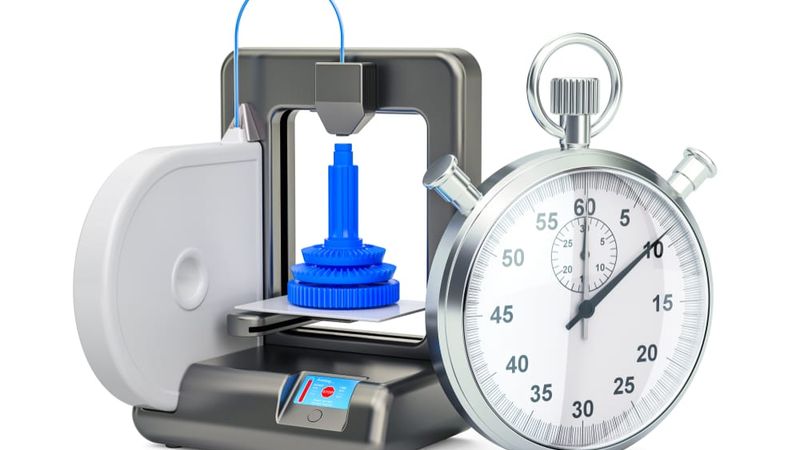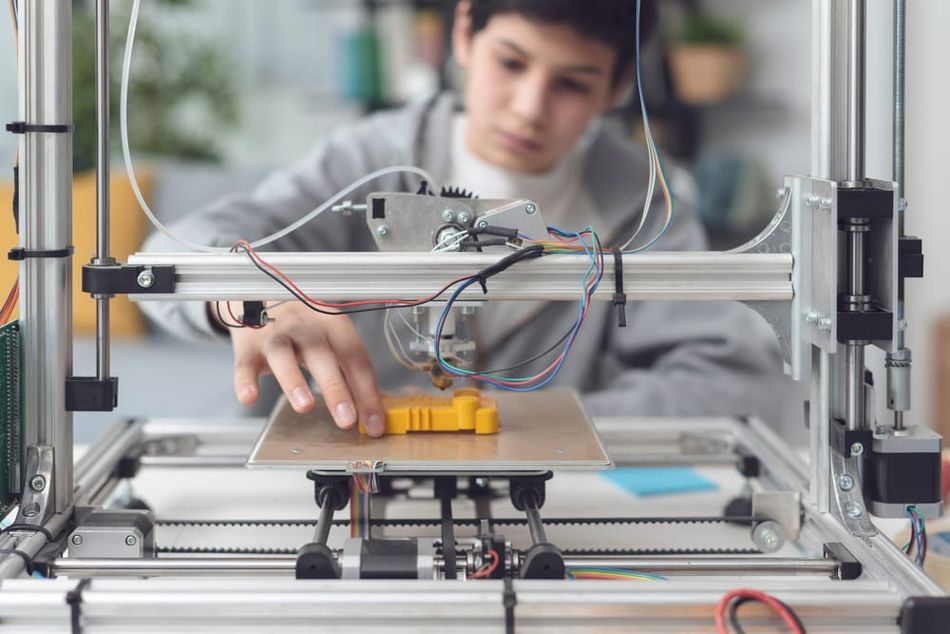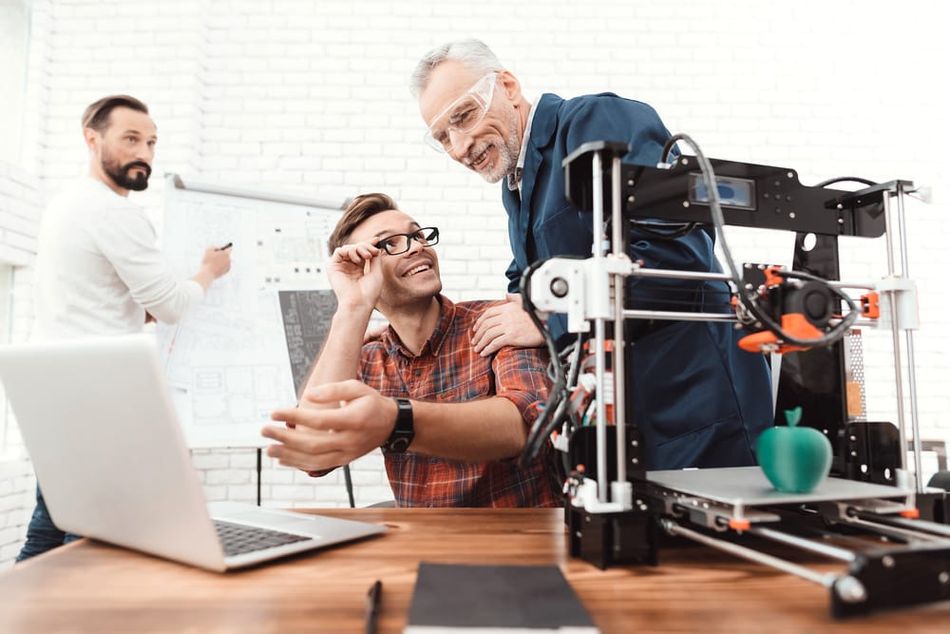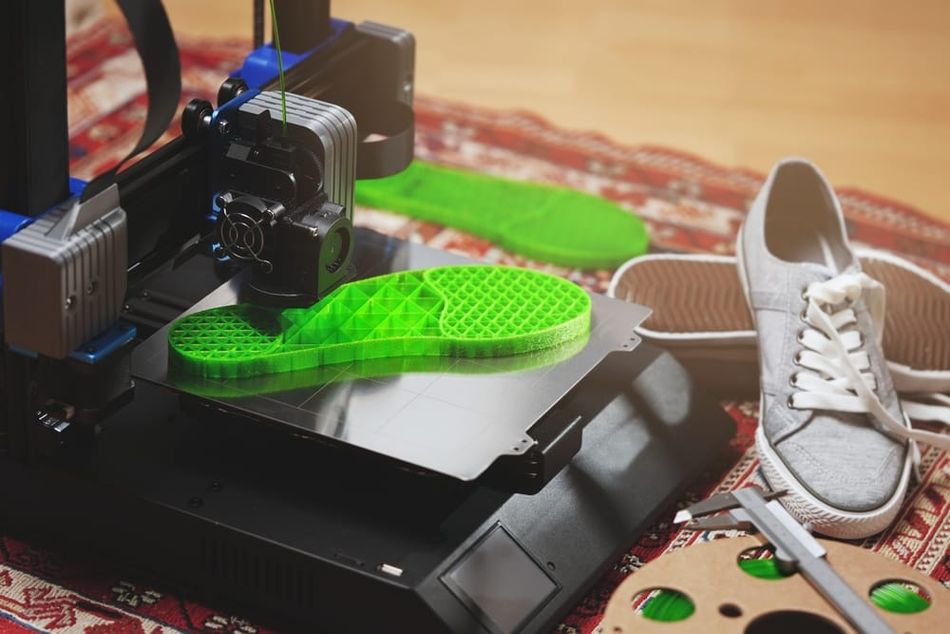PLA Print Speed: Best Print Speed Settings and More
PLA is one of the fastest filaments out there, your PLA print speed is also determined by print settings, hardware, and other factors.

3D print speed refers to the speed of printhead movement
PLA is far from a perfect 3D printing material — it is very brittle and can deform if left out in the sun — but its excellent melt flow characteristics make it a fast and user-friendly filament.
Beginner and expert 3D printer users alike often want to improve their PLA print speed. While this low-cost filament is one of the fastest-printing materials out there, its speed can be further increased with print setting adjustments and improved hardware.
This article goes over the basics of PLA printing speed. It looks at the typical printing speeds of FDM printers, the ways you can adjust print speed settings (and how this affects the PLA print), and PLA print speed compared to other 3D printing filaments.
What is Print Speed?

When talking about 3D printing speeds, it’s easy to get vague with the language we use. For example, when we say that a small, simple part can be printed “quickly,” what we mean is that the part can be printed in a short amount of time (because it is small and requires fewer movements of the printhead than a larger part). Make no mistake, this is a helpful way to think about printing, but it doesn’t tell us much about actual print speed.
Lots of factors can affect the time it takes to finish a print. Using a wide-diameter nozzle, for example, allows you to extrude a greater volume of material at once. And adjusting settings like infill and layer height can also shave minutes or hours off total print time: setting a greater layer height reduces the total number of layers, while minimizing infill density means the printhead is laying down less material per layer. Furthermore, adding extra material via supports, skirts, and rafts, will increase the overall printing time.
However, printing time is not the same as 3D print speed. If it takes you a day to build a LEGO house and it takes a building contractor a week to build a real, bricks-and-mortar house, this doesn’t mean that you have demonstrated a faster building speed than the professionals. On the contrary, the builders will probably have laid down each brick far more speedily than you. And this speed of action is what we need to focus on when it comes to printing speed.
3D print speed is simply the rate at which the printhead moves along the X and Y axes as it puts down a layer of material. A fast 3D print speed will reduce overall print time, but prints printed “fast” can still take a long time — when the part has large dimensions, for instance, or if using a very low layer height. Usually defined in millimeters per second (mm/s), 3D print speed can also vary across the build: sometimes a slower speed is used for the first layer (to ensure good adhesion to the build surface) and a faster speed used for infill (where accuracy matters less).
What is the Normal Printing Speed of a 3D Printer?
In the world of FDM printing, which we will focus on here, printing speed refers to how quickly the printhead moves along the X and Y axes while it is depositing material.[1] It has a big impact on overall printing time, but it is not the only factor.
The printing speed of an FDM printer can be adjusted using printer firmware or slicing software. In general, slower printing speeds produce better results, so very high speeds are typically reserved for rapid prototyping. Printing too fast can lead to defects, lower dimensional accuracy, and weaker parts.[2]
The best print speed for everyday prints (medium quality) is about 50–60 mm/s. However, users should note that some materials can be printed very quickly (e.g. PLA) while some require a slower rate to prevent warping or print failure (e.g. TPU).
Different pieces of hardware offer different print speed capabilities, though this is not usually a key metric to look out for when selecting a printer. Most common entry-level printers (such as the Creality Ender 3 and Prusa Mini) offer a maximum print speed of around 200 mm/s. In reality, however, users will not actually be able to print at that speed. This is partly because filament can’t be melted and extruded that quickly. Furthermore, because the printhead typically makes quite short movements while it prints, it rarely has enough time to accelerate to its maximum speed.
Other additive manufacturing technologies define print speed in different ways. With vat photopolymerization technologies like SLA and DLP, there is no printhead movement, so print speed is often defined by how many millimeters can be printed along the Z-axis per hour. Such a measurement is more useful with SLA and SLP (as well as SLS) than it is with FDM, because there are fewer factors that can influence it (such as nozzle size).
PLA Print Speed Considerations
Polylactic acid (PLA) is a popular material for 3D printing due to its favorable characteristics, including its biodegradability, low toxicity, and ease of use. Users can also achieve very high PLA print speed thanks to the relatively low melting point of PLA compared to other thermoplastics commonly used in 3D printing, such as ABS or PETG. PLA typically melts at around 180 to 220 degrees Celsius, depending on the specific formulation and brand.
This lower melting point means that PLA can be heated up quickly in the printer's hotend, reducing the time required for the printing process to reach optimal temperature.
Additionally, PLA has excellent flow properties when melted, allowing it to be extruded smoothly and with precision. This enables faster printing speeds without sacrificing print quality. Furthermore, PLA has minimal warping and shrinkage during cooling, reducing the likelihood of print failures and allowing for faster print speeds and increased layer adhesion.
Overall, the combination of PLA's low melting point, good flow properties, and minimal warping make it an ideal material for rapid 3D printing, enabling users to produce high-quality prints efficiently.
Print Speed Settings for Your 3D Printer

3D print slicing software applications like Cura and Simplify3D offer a range of print speed settings beyond the default print speed, which is usually set in mm/s. These settings allow the user to fine-tune the rate at which the printhead moves in different situations: during the first layer, when printing infill, when printing outer walls, and also when moving without printing.
Although different slicers sometimes use their own terminology, below are the most common print speed settings available for FDM printing.
Print speed
Otherwise known as default printing speed or overall printing speed, this is the most important setting for determining your 3D printer speed and achieving faster prints. Usually defined in mm/s, the print speed setting tells the printhead how quickly it should move along the X and Y axes while it is depositing material. Most slicers will automatically calculate how much filament will need to be extruded in order to keep up with the selected print speed.
We can call this value the “default” print speed because other settings will at times override the value. In fact, some of the following settings can — depending on the specific slicer used — be defined relative to the default print speed (i.e. as a percentage of it).
Infill speed
Most 3D prints are not printed fully solid, as this uses up a lot of material, requires lots of time, and provides few physical benefits. Instead, the interior structure of a print consists of a pattern known as infill, which can vary in terms of shape and density.
Because the infill pattern cannot be seen once the print is complete, it can be beneficial to print the infill faster than the exterior. Although this may result in some imperfections, these imperfections will be less of a problem than they would be on the outside of the print.
Travel speed
Travel is when the printhead has to jump from one part of the build to another without depositing any material. Increasing the travel speed can help reduce oozing and stringing (when unwanted material drips from the nozzle) but can also lead to other imperfections.
In Simplify3D, travel speed is referred to as “X-Y Axis Movement Speed.” The value is usually defined in mm/s and can sometimes be found under “retraction” settings if not in speed settings.
Initial layer speed
The first layers of a print are critical. If the first layer does not adhere well to the build surface, the entire part can dislodge during printing, causing print failure. It can therefore be beneficial to print the first layer(s) at a reduced speed, to give the printed object the best chance of success. This value may be set in mm/s (Cura) or as a percentage of the default print speed.
Number of slower layers
As explained above, most FDM users configure their print settings to have a slower initial layer. But rather than immediately going full speed on the second layer, it can be beneficial to gradually increase the print speed over a few layers until the normal speed is reached.
The number of slower layers setting determines how many layers it should take to go from the initial layer speed to the normal print speed. For example, if the value is set to 5, the printer will increase the speed in small increments over the first five layers before reaching the normal print speed on the sixth layer.
Support structure speed
Printer users often favor a higher speed for support structures, since these disposable sections of material do not need to be particularly accurate or visually pleasing. On Cura, there is a distinction between the “support infill” (the bulk of the support structure) and the “support interface” (where the support meets the actual part). The support interface speed should be slower, as good adhesion between the support and printed model is important.
Other section-specific speed settings
Some slicers allow for adjustment of print speed for the following parts of the print. Most are set in mm/s or as a percentage of the default print speed.
Outer/inner wall speed (may also be called “outline” or “perimeter” speed)
Top and bottom layers speed
Top surface skin speed
Skirt and brim speed
How Does Print Speed Affect Your Print?
When running a print for the first, it can be tempting to crank up the print speed in order to reduce the overall printing time. However, print speed affects the print in many ways: FDM users must consider how print speed will affect bed adhesion, print quality, and the potential for errors.
Risks of printing too fast
Perhaps unsurprisingly, printing too fast is more likely to lead to issues than printing too slowly, with negative effects including lower dimensional accuracy and part strength.
The most common defects from printing too fast include:
Ringing or ghosting
The phenomenon of ringing (sometimes called ghosting or rippling) is a 3D printing defect characterized by a rippled or wavy appearance to the exterior surfaces of parts. It occurs when layers are not properly aligned, which is itself caused by excessive vibration or out-of-control printhead movements.
Reducing print speed is one of the most effective ways to prevent ringing. This is because faster speeds cause greater vibrations and lead to greater speed variations when the printhead changes direction.
Poor layer adhesion
As mentioned in our discussion of print speed settings, it is vital to print slowly on the first layer in order to guarantee good bed adhesion. But inter-layer adhesion is also important, and too-fast speeds can reduce the ability of each layer to bond with the next.
Reducing print speed on the first layer can help ensure good adhesion to the build plate, and reducing overall print speed can help prevent delamination.
Under-extrusion
If not enough filament is fed to the hotend, printing can suffer from under-extrusion. The result is gaps, holes, missing layers, and other deformities.
Under-extrusion can occur when the print speed exceeds the flow rate, i.e. when the printhead is trying to lay down more material than is being supplied to it. Generally, however, this should not be an issue, as your slicer should automatically calculate a flow rate suitable for the print speed.
Clogging with flexible filament

When printing flexible materials like TPU and TPE, excessive print speeds can cause the soft and pliant material to bend the wrong way and get stuck during extrusion. Using a slow and consistent print speed (i.e. not deviating from the default speed for first layer, infill, support structures, etc.) can help prevent this issue.
Recommended reading: What are flexible filaments and which one should you choose?
Risks of printing too slow
In general, a slower 3D printer print speed results in higher quality. Nonetheless, printing too slowly can cause issues of its own. These issues generally relate to overheating: if the filament stays in the nozzle chamber too long, it can get too hot and cause deformations on the part.
Finding the Best Print Speed by Testing
A good way to find the best print speed for your chosen combination of hardware and material is to download a print speed test model (or print speed tower).
These printable 3D models work in a similar way to temperature towers. They consist of several identical sections designed to be printed at different speeds (by inputting specific instructions to your slicer). Each section is labeled with the relevant value in mm/s. When the tower is printed, a visual inspection can determine to what extent print quality suffers at higher speeds.
STL files for print speed towers (like this one) can be found on Thingiverse and other 3D model sharing platforms.
Recommended reading: How to find free STL files
Print Speeds for PLA and Other Filaments
Some 3D printing materials are more suited to high-speed printing than others. For instance, those that can be melted quickly are suited to faster flow rates, which in turn allows for fast printing of the material.
3D printing material | Typical print speed | Upper limit | Explanation |
PLA | 60 mm/s | 150 mm/s | When print quality is important, most users will print PLA at a maximum of 60 mm/s due to hardware limitations. However, the low extrusion temperature of PLA makes it easy to rapidly print the material without the risk of it warping as it cools. |
ABS | 60 mm/s | 60 mm/s | For high-quality prints, ABS requires a similar print speed to PLA. But the material has a higher extrusion temperature than PLA and is more prone to warping, capping its maximum speed limit. |
PETG | 50 mm/s | 60 mm/s | PETG requires fairly fast travel speeds due to its proneness to oozing and stringing, but it suits a slower print speed, generally around 50 mm/s for end-use printed parts. |
TPU / flexible filament | 20 mm/s | 20 mm/s | Flexible filaments like TPU require very slow print speeds compared to rigid filaments like PLA. This is because extruding too fast can lead to clogs and jams, especially with Bowden extruders. |
Nylon | 40 mm/s | 50 mm/s | Nylon can be printed at faster speeds than TPU but not as fast as common materials like PLA, ABS, and PETG, partly due to its high extrusion temperature. |
High-speed PLA formulations refer to specially engineered blends of polylactic acid (PLA) filament designed for rapid 3D printing. These formulations are supposedly optimized to enhance the printing speed while maintaining the desirable properties of PLA, such as biodegradability, low toxicity, and ease of use.
Several factors could contribute to an increased speed. Firstly, these formulations often contain additives or modifiers that improve the material's melt flow characteristics, allowing it to extrude more smoothly and consistently at higher speeds. Additionally, high-speed PLA blends may incorporate additives to enhance heat conductivity or reduce viscosity, enabling faster heating and melting within the 3D printer's hotend.
That being said, these materials offer marginal gains at best, and a high-quality "regular" PLA will often print far more successfully than a supposedly high-speed PLA.
Some popular "high-speed" PLA filaments include:
- eSun ePLA-HS High Speed Printing PLA 3D Printer Filament
- MatterHackers MH Build Series High Speed PLA-HS Filament
- SUNLU HS_PLA (High Speed PLA) 3D Printer Filament
Better Ways to Increase PLA Print Speed
Buying a high-speed PLA filament won't let you print at 100 mm/s if using low-cost 3D printer. Those looking to achieve the highest possible PLA print speeds will need to invest in high-performance hardware capable of pushing PLA to its full potential.
One way to print quickly is to use a CoreXY printer. CoreXY 3D printers work differently to ordinary Cartesian printers, where the X and Y axes are controlled by separate motor movements. With a CoreXY printer, the X and Y motors work together, enabling smoother hotend movement. This in turn enables faster printing speeds without print defects.
Firmware adjustments can also have a big impact on print speed. For example, many users of the popular Creality Ender 3 have achieved faster printing speeds by replacing the printer’s default Marlin firmware with Klipper firmware, which provides advanced motion kinematics. These motion kinematics result in faster speeds and improved control over acceleration.
Conclusion
3D print speed is one of the most important 3D printer settings. While we all want to print our PLA parts as quickly as possible, it is important to recognise the limitations of print speed and the negative effects of printing too fast, such as ghosting, poor adhesion, and jams. Beginners should start by printing at the recommended speed of around 50–60 mm/s then experimenting with different settings when they have more experience and confidence.
Frequently Asked Questions (FAQ)
Can you print more quickly with PLA than other materials?
The low melting point of PLA allows it to be extruded quickly. The material also solidifies quickly, allowing for fast printing speeds without risking part failure.
Are some PLA filaments faster than others?
While all PLA filaments can be printed at fairly fast rates, some manufacturers offer "high-speed" versions of PLA filament that promise faster extrusion and the ability to print at even faster rates. While these materials are excellent for rapid prototyping, the presence of additives may compromise the quality of the material in other areas.
Can I modify my 3D printer to print PLA faster?
Some hardware upgrades can help improve your PLA print speed. These include installing a high-flow hotend to increase material flow rate, upgrading to a direct drive extruder for better filament control and faster retraction, or using a larger nozzle diameter (0.6 mm or 0.8 mm) to allow for thicker layers and faster extrusion.
References
[1] Agarwal KM, Shubham P, Bhatia D, Sharma P, Vaid H, Vajpeyi R. Analyzing the impact of print parameters on dimensional variation of ABS specimens printed using fused deposition modelling (FDM). Sensors International. 2022 Jan 1;3:100149.
[2] Miazio Ł. Impact of print speed on strength of samples printed in FDM technology. Agricultural Engineering. 2019;23.
Table of Contents
What is Print Speed?What is the Normal Printing Speed of a 3D Printer?PLA Print Speed ConsiderationsPrint Speed Settings for Your 3D PrinterPrint speedInfill speedTravel speedInitial layer speedNumber of slower layersSupport structure speedOther section-specific speed settingsHow Does Print Speed Affect Your Print?Risks of printing too fastRisks of printing too slowFinding the Best Print Speed by TestingPrint Speeds for PLA and Other Filaments3D printing materialTypical print speedUpper limitExplanationPLA60 mm/s150 mm/sWhen print quality is important, most users will print PLA at a maximum of 60 mm/s due to hardware limitations. However, the low extrusion temperature of PLA makes it easy to rapidly print the material without the risk of it warping as it cools.ABS60 mm/s60 mm/sFor high-quality prints, ABS requires a similar print speed to PLA. But the material has a higher extrusion temperature than PLA and is more prone to warping, capping its maximum speed limit.PETG50 mm/s60 mm/sPETG requires fairly fast travel speeds due to its proneness to oozing and stringing, but it suits a slower print speed, generally around 50 mm/s for end-use printed parts.TPU / flexible filament20 mm/s20 mm/sFlexible filaments like TPU require very slow print speeds compared to rigid filaments like PLA. This is because extruding too fast can lead to clogs and jams, especially with Bowden extruders.Nylon40 mm/s50 mm/sNylon can be printed at faster speeds than TPU but not as fast as common materials like PLA, ABS, and PETG, partly due to its high extrusion temperature.High-Speed PLA? Choosing a Fast PLA MaterialBetter Ways to Increase PLA Print SpeedConclusionFrequently Asked Questions (FAQ)References